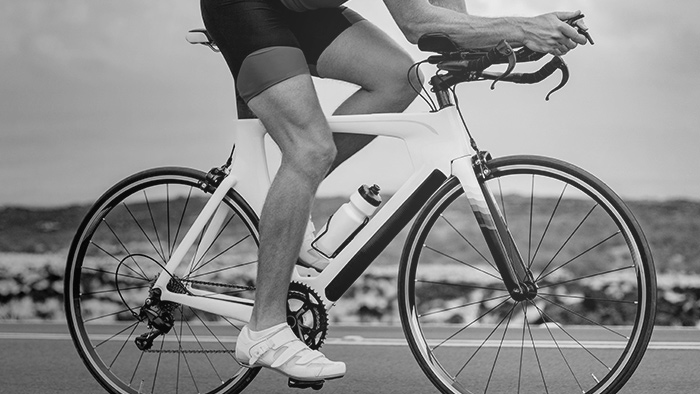A fateful 15 weeks ago, I put my powerful, 78-pound dog on a leash, put the leash on my wrist and jumped on my bike to ride about a block to the trailhead. Everything was going fine until a squirrel bolted across the road, and my dog applied all four legs of sprint. With a quick jack of the handlebars I was flying through the air, with the leash still wrapped around my wrist. I landed directly on my elbow and proceeded to flip into a snowbank.
Despite visiting a doctor two days after my fall, the x-ray looked fine and I did not receive an MRI until 3.5 weeks later. I could do almost everything except swim—the action of freestyle produced a horrible sharp pain and weakness down my arm. A visit to my PT and an MRI confirmed our worst suspicions, and I was diagnosed with a full thickness (torn from the bone) tear in the supraspinatus, a muscle in the rotator cuff of the shoulder.
The rotator cuff is a group of muscles and tendons that surround the shoulder joint, which keep the head of your upper arm bone firmly within the shallow socket of the shoulder. Rotator cuff injuries are common in people of all ages and across a large range of athletes. And while tendonitis and strains can generally be treated non-surgically, tears caused by trauma or overuse have a large chance of degenerating without surgery, especially in athletes who continue to use the shoulder.
After the MRI I was quickly scheduled for surgery with a shoulder specialist. It is recommended that surgery after a traumatic tear should be done as soon as possible. Waiting means an increase in the likelihood that the torn tendon will not be able to form scar tissue that not only helps it heal back to the bone but also allows it to function normally after rehabilitation.
Fortunately, 94% of individuals are happy with the results of rotator cuff surgery, although the larger the tear both the longer and more challenging the recovery and the more likely the results will not be as good.
Surgery
The surgery requires anesthesia, and about an hour of operating time. The doctor placed a small screw into the top of my humerus and then did two small stitches with polyethylene, which he said was pretty much impossible to tear. I was fortunate that the rest of my shoulder complex was in good condition, and that I went into surgery with full mobility.
Still, as anyone who has experienced it will tell you, the shoulder is the worst joint to cope with post surgery. At my pre-op appointment I was told to take narcotics the moment I felt any tingling or hint of pain, and the NP told me matter of factly, “this is the most painful shoulder operation.” I’m happy to say that ultimately no narcotics were needed, so advice here, listen to your own body!
I emerged from surgery with a pillow sling and directions to wear it 24/7 unless showering. I was allowed to use my body to swing my arm around, but I was directed not to actively use it or lift it. I could use the lower part of my arm only.
Recovery and Return to Sport
Recovery from rotator cuff surgery is listed as 6 months to a year, and if you’re an athlete, this can feel like an insurmountable amount of time. It is recommended that overhead athletes (anyone who uses the arm above 90 degrees- swimmers, tennis, lacrosse, baseball players…) do not return to their sport until they experience zero pain with rest of activity, have full strength in muscles across the affected joint, and have pain free shoulder range of motion.
In the first 5 weeks, I ran ‘gently’ and rode my trainer, but still emerged with what my surgeon called an ‘extremely stiff’ shoulder and was bumped immediately to intensive PT and stretching to return my mobility. One hands-on visit with my PT and I experienced relief I had not in 7 weeks. With mobility work, and gradual strengthening, I was on my way to a slow return to the shoulder I once had.
Another avenue to consider for recovery is non-western medicine. I was able to have time with Amber Myerowitz, an acupuncturist who performed both Electro-Acupuncture and Cupping on my back. She told me, “Both cupping therapy and acupuncture have similar goals in that they aim to relieve pain by mobilizing blood flow to the injured area to promote the body’s natural self-healing process.” A number of athletes have reported their own stories of acupuncture and cupping working to help them loosen and recover.
Prevention
“Good posture in the shoulder blades, stretching, and some very simple strengthening exercises will help prevent 99 percent of all shoulder problems you could have,” says orthopaedic surgeon Grant Garrigues. Consider your technique in overhead sports such as swimming. Don’t let tight shoulders from an aero bike position become the norm. Simple stretches such as wall angels, lying with a foam roller perpendicular to the spine and arms outstretched, and yoga shoulder openers are all good daily practices.
Something as simple as improper hand position in water entry during freestyle swimming, can put a repetitive stress on the shoulder that may result in damage.
Perhaps what stood out to me loudly here is that many rotator cuff injuries occur over time, and while youth may seem everlasting, the 60+ generation is paying for years of shoulder abuse. “About 50 percent of people over the age of 60 will have one.”
Take care of your shoulders! You may not recognize the work they are doing and the complexity of their performance until you are forced to confront an injury. While some accidental trauma is an unfortunate consequence of being an athlete, long term wear and tear and abuse can be minimized by proper stretching, strengthening and attention.


